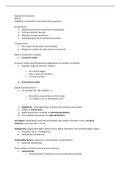Samenvatting
Summary Recap Introductory Econometrics, ISBN: 9781337558860 Econometrics
Summary study book Introductory Econometrics of Jeffrey Wooldridge, South-Western Educational Publishing - ISBN: 9781337558860, Edition: 7, Year of publication: - (Recap + lectures)
[Meer zien]





